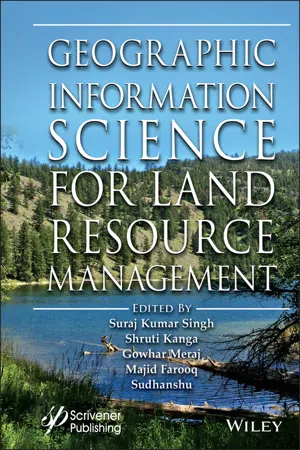
Geographic Information Science for Land Resource Management
- English
- ePUB (mobile friendly)
- Available on iOS & Android
Geographic Information Science for Land Resource Management
About this book
Geographic Information Science for Land Resource Management is a comprehensive book focusing on managing land resources using innovative techniques of spatial information sciences and satellite remote sensing. The enormous stress on the land resources over the years due to anthropogenic activities for commercialization and livelihood needs has increased manifold. The only solution to this problem lies in stakeholder awareness, which can only be attained through scientific means. The awareness is the basis of the sustainable development concept, which involves optimal management of natural resources, subject to the availability of reliable, accurate, and timely information from the global to local scales. GIScience consists of satellite remote sensing (RS), Geographical Information System (GIS), and Global Positioning System (GPS) technology that is nowadays a backbone of environmental protection, natural resource management, and sustainable development and planning. Being a powerful and proficient tool for mapping, monitoring, modeling, and managing natural resources can help understand the earth surface and its dynamics at different observational scales. Through the spatial understanding of land resources, policymakers can make prudent decisions to restore and conserve critically endangered resources, such as water bodies, lakes, rivers, air, forests, wildlife, biodiversity, etc. This innovative new volume contains chapters from eminent researchers and experts. The primary focus of this book is to replenish the gap in the available literature on the subject by bringing the concepts, theories, and experiences of the specialists and professionals in this field jointly. The editors have worked hard to get the best literature in this field in a book form to help the students, researchers, and policymakers develop a complete understanding of the land system vulnerabilities and solutions.
Frequently asked questions
- Essential is ideal for learners and professionals who enjoy exploring a wide range of subjects. Access the Essential Library with 800,000+ trusted titles and best-sellers across business, personal growth, and the humanities. Includes unlimited reading time and Standard Read Aloud voice.
- Complete: Perfect for advanced learners and researchers needing full, unrestricted access. Unlock 1.4M+ books across hundreds of subjects, including academic and specialized titles. The Complete Plan also includes advanced features like Premium Read Aloud and Research Assistant.
Please note we cannot support devices running on iOS 13 and Android 7 or earlier. Learn more about using the app.
Information
1
Climate Change in South Asia: Impact, Adaptation and the Role of GI Science
1.1 Introduction
1.2 Climate Change
1.3 Climate Change Trends in South Asia
Table of contents
- Cover
- Table of Contents
- Title Page
- Copyright
- Preface
- Acknowledgements
- 1 Climate Change in South Asia: Impact, Adaptation and the Role of GI Science
- 2 Sustainable Land Resource Management Approach and Technological Interventions – Role of GI Science
- 3 GI Science for Assessing the Urban Growth and Sustainability in Agra City, India
- 4 The Use of GI Science in Detecting Anthropogenic Interaction in Protected Areas: A Case of the Takamanda National Park, South West Region, Cameroon
- 5 Urban Heat Island Effect Concept and Its Assessment Using Satellite-Based Remote Sensing Data
- 6 Remote Sensing for Snowpack Monitoring and Its Implications
- 7 Spectral Ratioing: A Computational Model for Quick Information Retrieval of Earth’s Surface Dynamics
- 8 Delineation of Surface Water in Mining Dominated Region of Angul District of Odisha State, India Using Sentinel-2A Satellite Data
- 9 Mapping Seasonal Variability and Spatio-Temporal Trends of Water Quality Parameters in Wular Lake (Kashmir Valley)
- 10 Water Quality Zoning Using GIS & Remote Sensing: A Case Study of Tehsil Matta District Swat Pakistan
- 11 Assessing the Impacts of Global Sea Level Rise (SLR) on the Mangrove Forests of Indian Sundarbans Using Geospatial Technology
- 12 Sustainable Water Resource Management Using Watershed Morphometry–A Case Study of Giri River Catchment, Himachal Pradesh, India
- 13 Improving the Procedure for River Flow Measurement and Mapping: Case Study River Plitvica, Croatia
- 14 Spatiotemporal Analysis of Forest Degradation in South Chotanagpur Division of India
- 15 Forest Fire Risk Assessment Using GIS Science – A Case Study of South India
- 16 GI Science for Land Use Suitability Analysis in the Himalayas – A Case Study of Himachal Pradesh, India
- 17 Using Remote Sensing Data and Geospatial Techniques for Watershed Delineation and Morphometric Analysis of Beas Upper Catchment, India
- 18 Sub-Watershed Prioritization for Soil and Water Conservation – A Case Study of Lower Wardha River, Maharashtra, India, Using GI Science
- 19 Understanding Hydrologic Response Using Basin Morphometry in Pohru Watershed, NW Himalaya
- 20 Sintacs Method for Assessment of Groundwater Vulnerability: A Case of Ahmedabad, India
- Index
- End User License Agreement